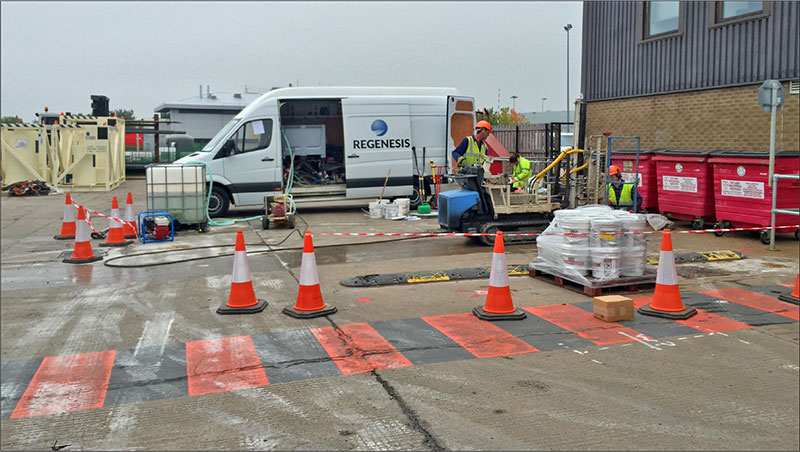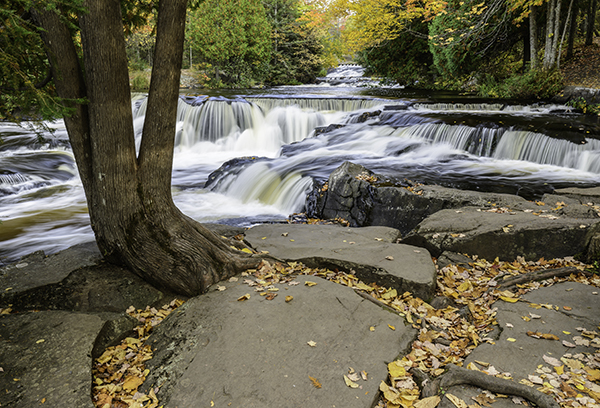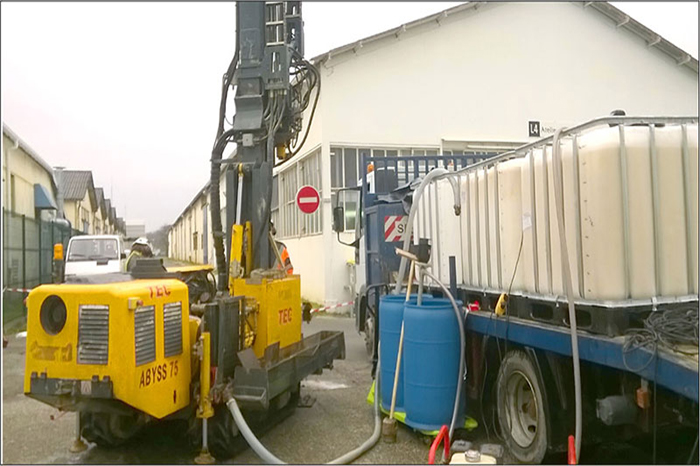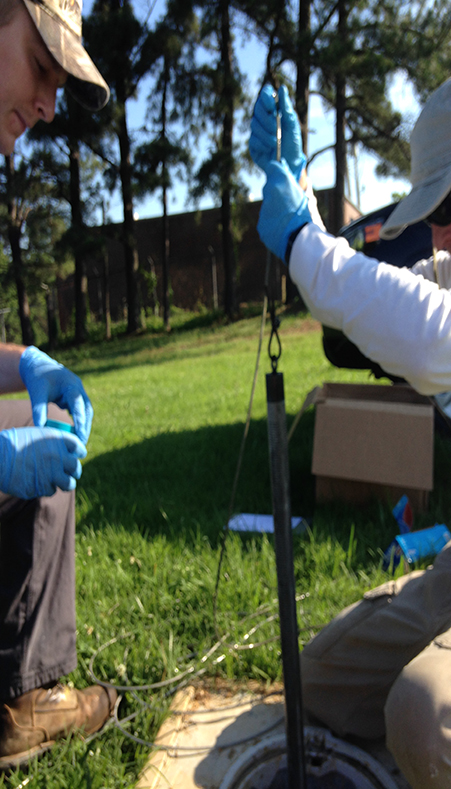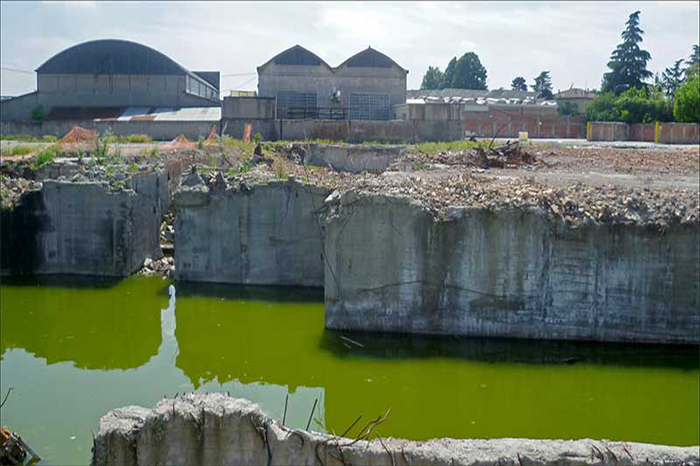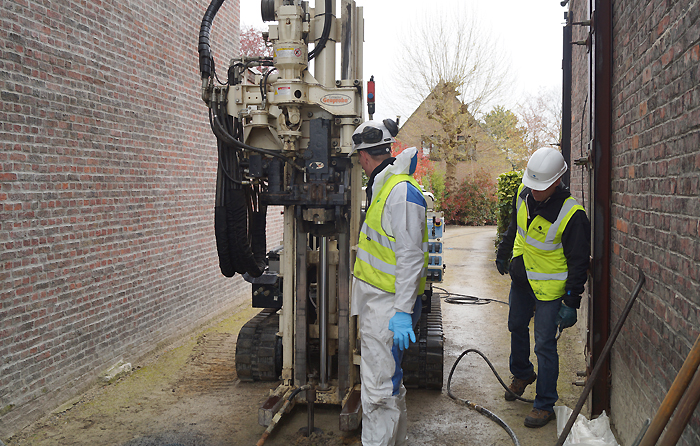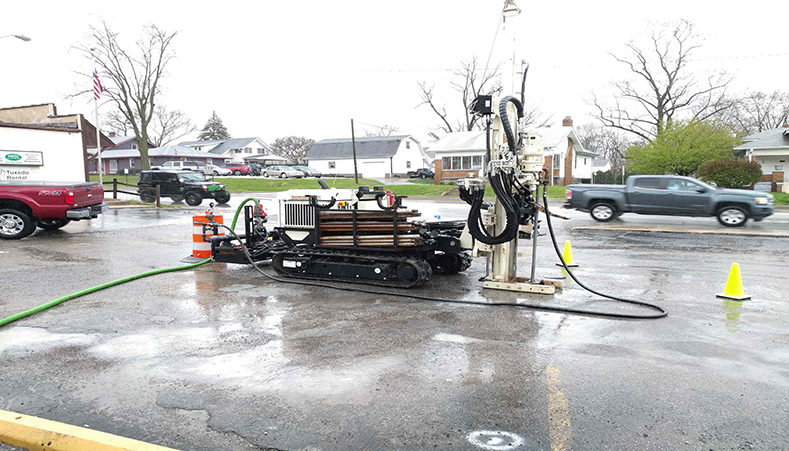Treatment of mixed chlorinated ethenes and ethanes at an active site, UK
Introduction
REGENESIS was approached to offer an in situ remedial solution to address high levels of mixed chlorinated solvent (TCA and TCE) contamination of the groundwater at a site in northeast Scotland. At the time, an ongoing DPVE system was operating, but was unable to achieve the remediation goal of a 75% reduction in chlorinated solvent mass. Furthermore, a supplementary MIP investigation showed that there was more contamination at depth (>6m) which the DVPE system was not able to reach.
Download pdf2m 42s reading time
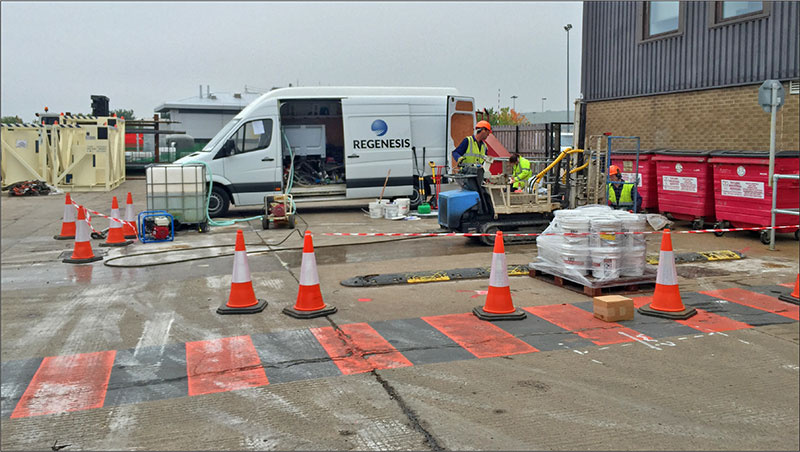 Fig. 1 REGENESIS Remediation Services applying 3DMe and BDI Plus on site
Fig. 1 REGENESIS Remediation Services applying 3DMe and BDI Plus on site
The initial design was based on treatment between 3 – 9m BGL of the aquifer across a 1,200m2 using 3DME and BDI with the preferred method of application being direct push injection. However, during the MIP investigation progression of the rods deeper than 6mBGL was found to be difficult. This raised concerns that (1) direct push injection would not be able to reach 9m BGL and (2) injection of the required dose of 3DMe may not be possible. REGENESIS were therefore asked to undertake a pilot study over a limited area to demonstrate that the works were possible. This was completed successfully and also showed excellent dose response and demonstrated to the site owners that the works (which were completed at night) would not have a deleterious effect on their operations.
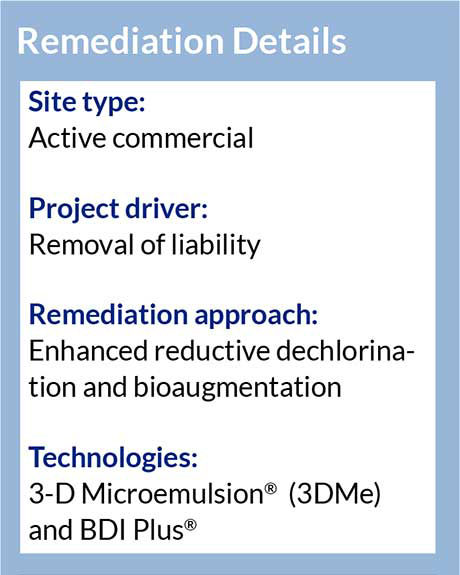
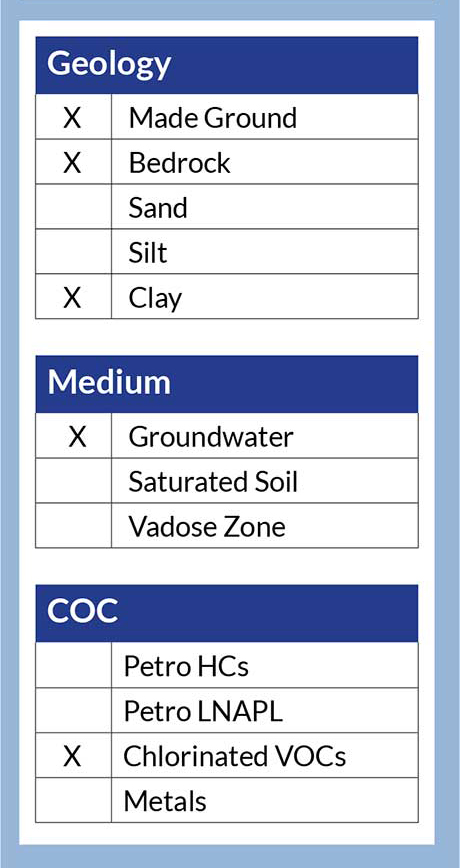
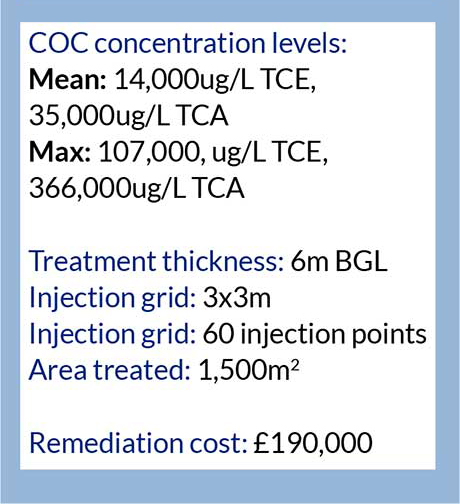
Full Scale Application
The pilot trial was conducted over two days (see figure 1) during which the direct push injection rig had no problems getting the injection rod to the required depth of 9m BGL (unlike the MIP). Furthermore, the required volume of 3DMe was accepted by the aquifer with minimal daylighting/surfacing.
Following the MIP and pilot, the fullscale design was tailored to provide the most cost effective approach for the site. 60 direct push injection points were completed over 10 nights, with no disturbance to the site operations.
The direct push injection points were centred on BH 11, a pre-existing well, to ensure we had good baseline data. Both BH11 and the surrounding wells were monitored over 8 months to assess the effect and distribution of 3DMe.
Results
Following the injection works, quarterly validation monitoring was completed. Post injection monitoring showed no inhibition of parent compound degradation due to the mixed halogenated compound plume. 98% and 99% reduction in mean concentration of TCA and TCE respectively.
Full reductive dechlorination was achieved with no build up in daughter products (see fig 2 and 3). The validation curves suggest that both biotic and abiotic degradation occurred.
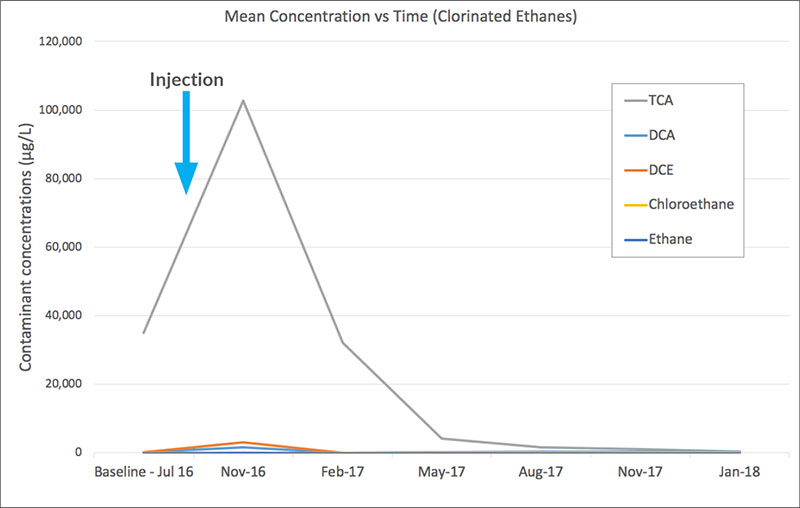
Fig. 2 Mean concentrations of Chlorinated Ethanes over time
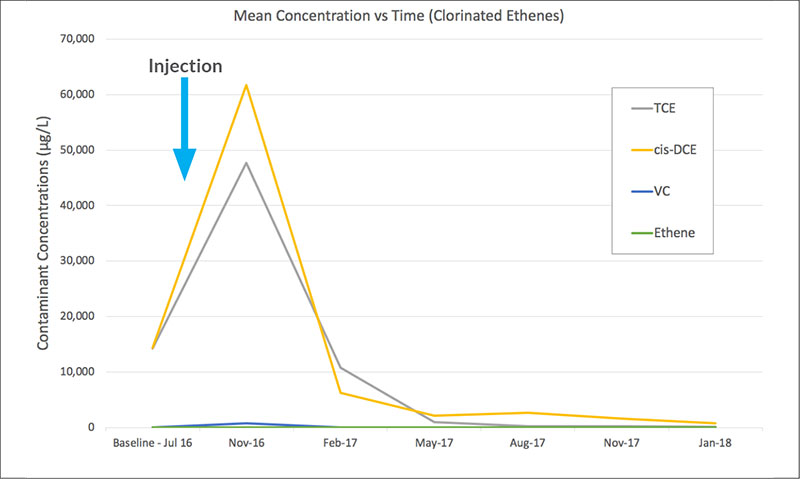
Fig. 3 Mean concentrations of Chlorinated Ethenes over time
Abiotic degradation occurred through the production of reduced iron species by the production of low redox conditions created by the 3DMe.
What’s Special
- A limited pilot study was used to prove the practicality and efficacy of the proposed approach. This area did not require further injection, so added little extra cost to the remediation of the site.
- Bioaugmentation using BDI+ avoided any inhibition of either chlorinated ethenes and ethanes by ensuring that the microbial consortia contained viable counts of dehalogenating bacteria specialising in either contaminant group.
- Very high levels of contamination, suggestive of DNAPL, were reduced to very low concentrations within 18 months.
- No build up of degradation products occurred, showing full reductive dechlorination was achieved and sustained.
- No disturbance of the onsite operations occurred during the limited injection time onsite, with the remediation occurring under the site as it continued to function normally.
- Remediation goals were achieved.
Fig. 4 REGENESIS’s team onsite
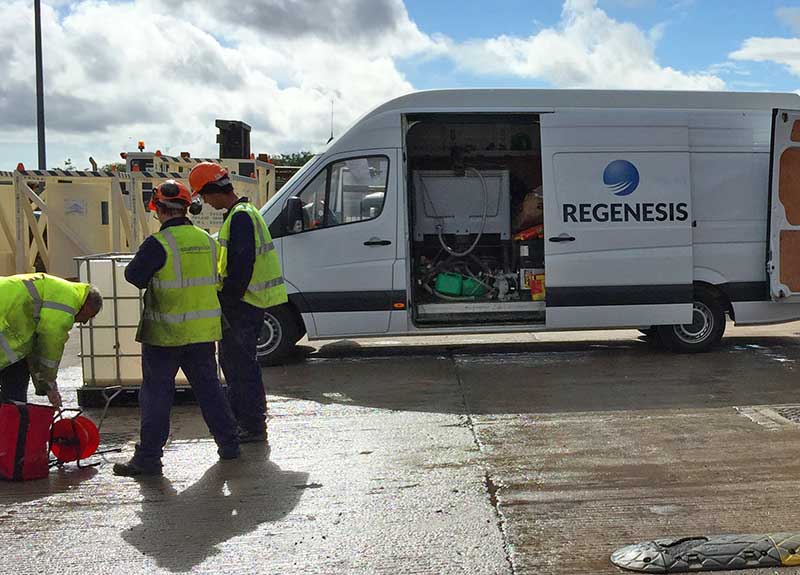
Advanced Remedial Technologies Restore Neighborhood
Former Michigan Industrial Site Treated Using Combined Remedy Approach
This case study reviews a former plating facility in southwest Michigan that had released chlorinated volatile organic compounds (cVOCs) into shallow groundwater, resulting in a ¼-mile long contaminant plume. In response, the Michigan Department of Environmental Quality (MDEQ) and the environmental firm, DLZ, implemented a combined remedy which included mitigating vapor intrusion in the residential basements and treating the groundwater plume with a novel, multi-phase in situ bioremediation approach.
- Application of combined REGENESIS technologies to biodegrade contaminants, prevent further plume migration, and protect occupants from the threat of vapor intrusion.
- Reduction of the total cVOC plume extent by 95% and reduced mass by 99.8%.
- Positive results indicating the degradation process is ongoing and processing.
8m 54s reading time
In Situ Treatment of Dichloroethene and Vinyl Chloride in Brussels, Belgium
Integrated remediation allows for redevelopment of historic industrial site. Read the case study.Read More
In-Situ Bioremediation at a French Airport in Southwest France
Successful standalone treatment of a large plume with difficult site conditions. With a longevity of minimum 4 – 5 years, 3DMe was selected to remediate the site from a single application. This removed the need for further application on this busy factory site.
and allowed the contamination within the overlying clay layer to be addressed, avoiding a rebound due to back-diffusion.Read More
Back Diffusion of VOCs from a Fractured Sandstone Aquifer Treated at Former Industrial Facility
Project Highlights
Large-scale pilot tests confirm management of chlorinated VOC back diffusion from fractured bedrock aquifer
- Tests concluded degradation along biotic and abiotic reductive pathways
- Advanced sorbent technology extends treatment longevity to manage to manage long-term back diffusion
2m 20s reading time
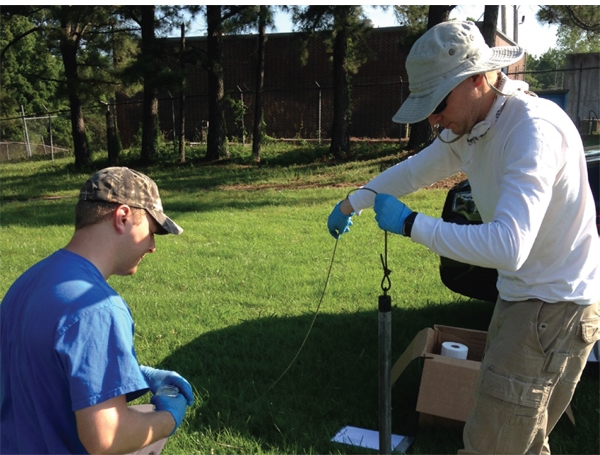
Project Summary
Fractured bedrock aquifers can be extremely heterogeneous which not only results in complex dissolved plume behavior, but can also hinder in situ remediation efforts that rely on an injection of amendments to promote microbial activity and abiotic degradation. However, due to the potentially high cost of a pump and treat remedy at a former industrial site in Arkansas, WSP determined that an in situ pilot test with advanced substrates was warranted.
At the Arkansas site, a 2016 pilot study was conducted using a multifunctional amendment formulation. REGENESIS® 3D-Microemulsion®, BDI Plus®, and CRS® were injected to remediate affected groundwater within a fractured sandstone bedrock aquifer impacted by chlorinated solvents. The contaminants at the site included trichloroethene (TCE), 1,1,1-trichloroethane (TCA), and degradation products. The plume on site underlies several developed properties and threatens a stream located approximately 1,500 feet from the source area. Results of the first pilot study yielded an 82% reduction within 9 months was measured approximately 80 feet from the application location.
A second pilot study was undertaken in 2017 to emplace a sorbent technology with long-lasting treatment capacity (PlumeStop®) on bedrock fracture faces to manage back diffusion from the bedrock primary porosity. This test also included the addition of bioremediation amendments to permanently degrade the sorbed contaminants. The 2017 treatment included PlumeStop and bioremediation amendments. After only one month, an 81% reduction was achieved in samples located 50 feet downgradient.
Preliminary indications of these amendment formulation tests are extremely promising in treating contaminant back diffusion emanating from the fractured bedrock matrix in this aquifer. WSP is confident that favorable performance monitoring results will continue and the full-scale remedy for this complex geologic setting will include REGENESIS products that extend treatment longevity.
Technology Description
PlumeStop® is an innovative groundwater remediation technology designed to address the challenges of excessive time and end-point uncertainty in groundwater remediation.
3-D Microemulsion® is an engineered electron donor material that offers a novel three-stage electron donor release profile, pH neutral chemistry, and is delivered on-site as a factory emulsified product.
HRC® is an engineered, hydrogen release compound designed specifically for enhanced, in situ anaerobic bioremediation of chlorinated compounds in groundwater or highly saturated soils.
BDI Plus® is designed for use at sites where chlorinated contaminants are present and unable to be completely biodegraded via the existing microbial communities.
CRS® is a liquid iron-based reagent for the enhanced biogeochemical in situ chemical reduction (ISCR) of chlorinated contaminants.
Treatment of a Diverse Range of Contaminants, Emilia Romagna, Italy
Treatment of a very low permeability geology with mixed contaminants at varying concentrations, using multiple application methods and a range of different REGENESIS products.Read More
Successful Pilot Test at Former Dry Cleaner Site with Restricted Access
Double pilot test with PlumeStop and 3DMe on an urban contaminated site with restricted accessRead More
Former Dry Cleaning Site Makes Way for Community Hospital Following Successful Treatment Using a Combined Remedy Approach
cVOC Contaminants Reduced by 97% After Two Months
Project Highlights
- Two months’ post injection results show contaminants were reduced by 97%
- Combined remediation approach used to successfully keep project on budget and on schedule
- Remediation design and amendments applied provided speed and certainty allowing for project to move forward
1m 55s reading time
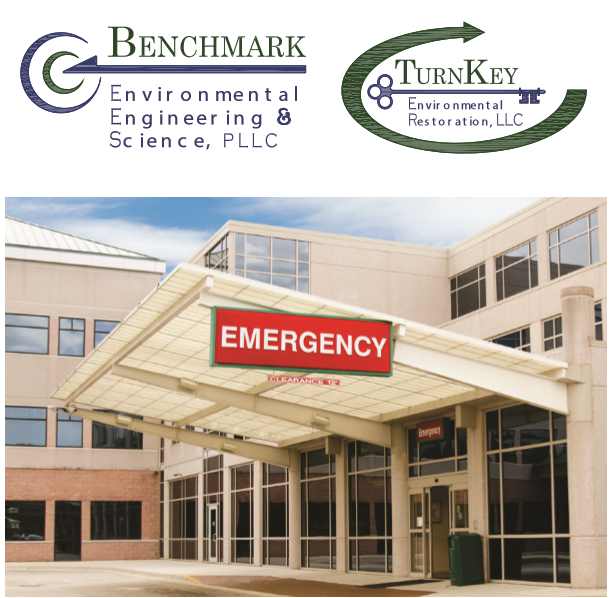
Project Summary
A former dry cleaning site in Western New York was targeted for redevelopment to make way for a multidisciplinary, world-class cancer center. Before redevelopment could get underway, the developer needed to address the cVOC levels found on site which exceeded state regulatory standards. The developer engaged Benchmark/Turnkey, a leading environmental firm in the Northeast, to develop a solution to address the contaminant levels found. Benchmark/Turnkey worked with REGENESIS® to design a remedial strategy that included 3D-Microemulsion®, Bio Dechlor Inoculum® Plus, and Chemical Reducing Solution® to reduce the PCE, DCE and TCE contaminants. The design focused on speed and certainty, since the site was tagged for immediate redevelopment. Using a direct push application of the amendments, Benchmark/Turnkey was successful in applying the combined remedial approach on budget and on schedule.
Technology Description
3-D Microemulsion is an engineered electron donor material that offers a novel three-stage electron donor release profile, pH neutral chemistry, and is delivered on-site as a factory emulsified product.
Bio Dechlor Inoculum Plus (BDI-Plus) is an enriched natural microbial consortium species of Dehalococcoides sp. (DHC). This microbial consortium has been enriched to increase its ability to rapidly dechlorinate contaminants during in situ bioremediation processes.
Chemical Reducing Solution is an iron-based amendment for in situ chemical reduction (ISCR) of halogenated hydrocarbon contaminants such as chlorinated ethenes and ethanes.
Results
Following the injection event, the team monitored the results and at two months found that total cVOC contaminant levels had been reduced by 97%. Based on the progress to date and the concentration of contaminants versus nutrients remaining in the groundwater, Benchmark/Turnkey expects to collect groundwater samples for two intervening semi-annual events then petition the New York Department of Environmental Conservation to discontinue groundwater monitoring.
About the Client
Benchmark Environmental Engineering & Science, PLLC is a licensed professional engineering company that provides comprehensive civil and environmental engineering services. TurnKey Environmental Restoration, LLC is a “sister” company that provides site investigation, remediation and infrastructure construction, and environmental and site management service.
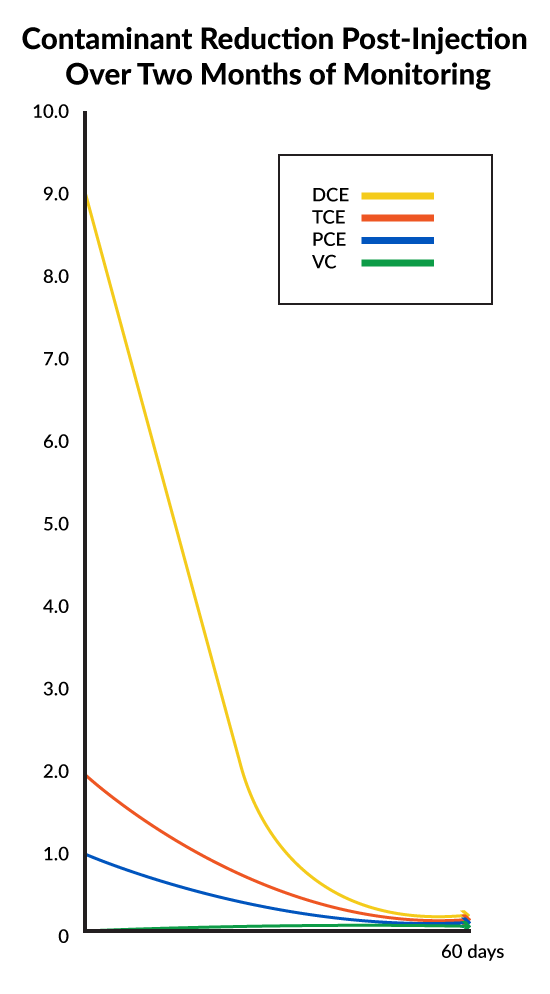
Enhanced Reductive Dechlorination Showing Positive Returns at Indiana Dry Cleaning Site
Project Highlights
- Combined remedies approach using an Enhanced Reductive Dechlorination (ERD) process successfully remediated an Indiana drycleaning site
- ERD process chosen eliminates need for long-term monitoring
- Contaminant concentrations reduced from thousands of μg/L pre-injection to single digits one month post-injection
2m 38s reading time

Project Summary
While the surrounding Mooresville, Indiana community applauds Crest Cleaners for proactively cleaning up a previously unidentified hazardous mess that was left behind from historic dry cleaning practices, the workhorses remediating the contamination are grinding away below the subsurface. Tiny microorganisms are destroying the PCE in the groundwater and reducing the concentration of the contaminant. It’s all a part of the “Enhanced Reductive Dechlorination,” (ERD) process, which is the primary approach of the Remedial Work Plan (RWP) being implemented by EnviroForensics®.
In addition to the potential for human health risks at the site as a result of soil or groundwater exposure, the contaminant plume in the groundwater represented a potential vapor intrusion risk to an offsite building. The project team debated between two viable options:
- Install, monitor, and maintain a Sub-Slab Depressurization System (SSDS) at the offsite location to mitigate the potentially harmful vapors underneath the building, which would have required years of maintenance and groundwater sampling; or
- Implement an ERD application to reduce the concentration of the groundwater plume, and eliminate potential vapor intrusion issues.
Based on the overall benefit to the community and to reduce stress and aggravation to adjacent property owners that comes with long-term monitoring, the project team chose option two.
Here’s how the remediation at this site worked. Naturally occurring bacteria called Dehalococcoides ethanogenes (DHC) are in the groundwater completing a process called reductive dechlorination where the chlorine atoms are cleaved off and replaced by hydrogen atoms. This process continues until the resulting compound is no longer dangerous. At this site, the process was occurring, but not at a rate that would make the cleanup cost-effective for the client.
In order to complete this cleanup we utilized a process called bioaugmented enhanced reductive dechlorination (ERD) and in situ chemical reduction (ISCR). The process begins by sampling the groundwater across the remediation area for contaminant concentrations and geochemical parameters including DHC populations to determine the dosage of injected materials required in each area of the site. Different areas received modified doses of materials based on the calculations completed by EnviroForensic’s geochemist.
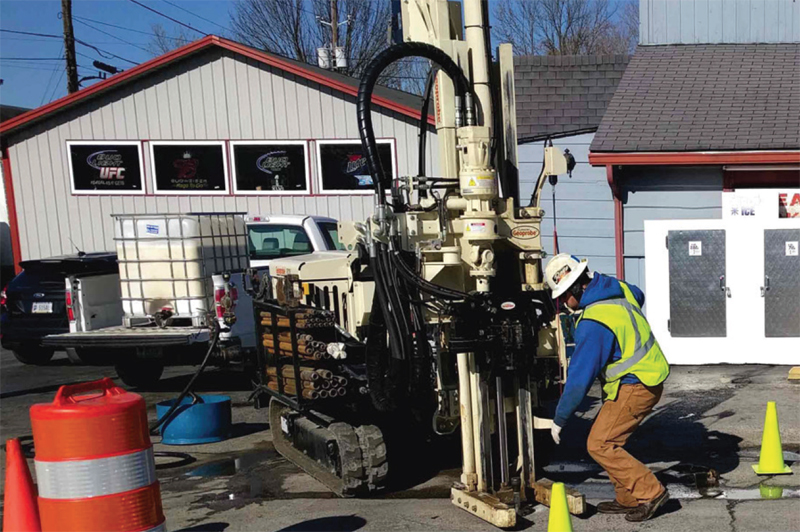 The ERD agent, 3-D-Microemulsion® (3DMe®) was injected along with Chemical Reducing Solution (CRS®), an ISCR augmentation. The ISCR agent delivers a source of ferrous iron, designed to precipitate as reduced iron minerals and provide an additional abiotic pathway for the destruction of PCE. The two work synergistically, increasing the cost effectiveness of the injection. The pre-sampling of DHC revealed that the population of DHC needed to be augmented. 10 gallons of BDI® Plus (DHC enhanced fluid) was injected at each of the 92 injection locations used for the ERD/ISCR. The combination of these three injected materials allows for minimal site disturbance and a high level of effectiveness for the cleanup of drycleaning solvents.
The ERD agent, 3-D-Microemulsion® (3DMe®) was injected along with Chemical Reducing Solution (CRS®), an ISCR augmentation. The ISCR agent delivers a source of ferrous iron, designed to precipitate as reduced iron minerals and provide an additional abiotic pathway for the destruction of PCE. The two work synergistically, increasing the cost effectiveness of the injection. The pre-sampling of DHC revealed that the population of DHC needed to be augmented. 10 gallons of BDI® Plus (DHC enhanced fluid) was injected at each of the 92 injection locations used for the ERD/ISCR. The combination of these three injected materials allows for minimal site disturbance and a high level of effectiveness for the cleanup of drycleaning solvents.
An often overlooked byproduct of the ERD process is methane. As a preventative measure, the field staff upgraded the site building SSDS with an intrinsically-safe fan and installed an intrinsically-safe SSDS at the offsite building as an interim measure. Soil gas points were also BDI Plus is an enriched natural microbial consortium containing species of Dehalococcoides sp. (DHC). This microbial consortium has since been enriched to increase its ability to rapidly dechlorinate contaminants during in situ bioremediation processes. Chemical Reducing Solution is an iron-based amendment for in situ chemical reduction (ISCR) of halogenated hydrocarbon contaminants such as chlorinated ethenes and ethanes. installed between the injection areas and the adjoining properties to the east. Additionally, extra intrinsically-safe fans and piping are ready to be installed.
Technology Description
3-D Microemulsion is an engineered electron donor material that offers a novel 3-stage electron donor release profile, pH neutral chemistry, and is delivered on-site as a factory emulsified product.
BDI Plus is an enriched natural microbial consortium containing species of Dehalococcoides sp. (DHC). This microbial consortium has since been enriched to increase its ability to rapidly dechlorinate contaminants during in situ bioremediation processes.
Chemical Reducing Solution is an iron-based amendment for in situ chemical reduction (ISCR) of halogenated hydrocarbon contaminants such as chlorinated ethenes and ethanes.
Results
The results from the first injection event were very promising. Groundwater contaminant concentration went down from thousands of μg/L pre-injection to single digits μg/L one month post-injection. Quarterly groundwater sampling will continue for a year or two to demonstrate that the contaminant plume is retreating or remediated. The ultimate goal of the ERD approach is to reach site closure quickly, and reduce the costs and health risks of this contamination.
Groundwater in Soils and Bedrock Treated at an Industrial Site, Sweden
High concentrations of TCE were found within the soil and groundwater and the contamination had infiltrated the underlying fractured mudstone bedrock…Read More

 Americas
Americas Europe
Europe Français
Français Deutsch
Deutsch Italiano
Italiano Español
Español